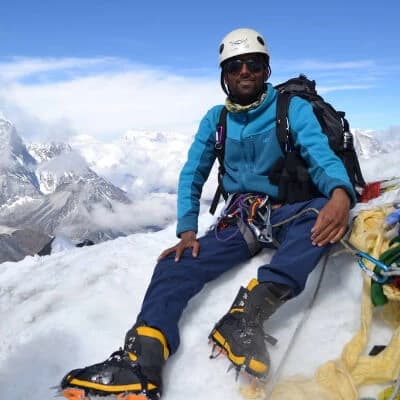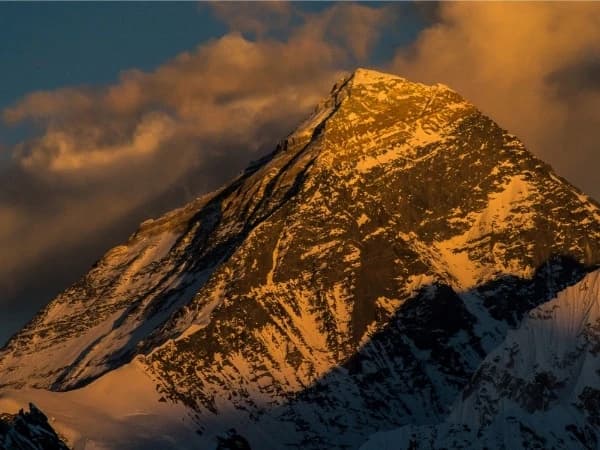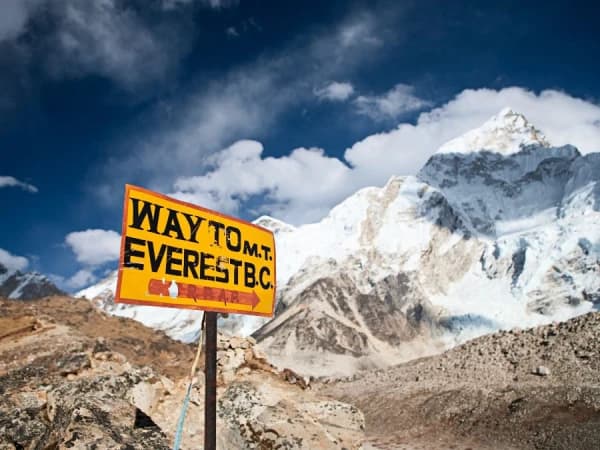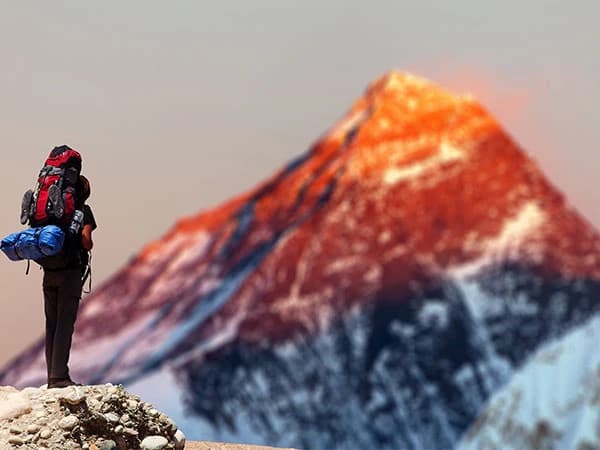Everest Vs Annapurna - Quick Differences
- The Annapurna Circuit Trek takes place in the central region of Nepal around the Annapurna Massif whereas and the Everest Base Camp Trek takes you to the eastern Himalayas with close up views of Mount Everest.
- ACT takes around 15 to 20 days, while EBC is of shorter duration comparatively and is generally completed in 12 to 14 days.
- The ACT begins from Besisahar or Bhulbhule through road access, whereas the EBC trek begins with an air travel to the high-altitude Lukla airport.
- The Annapurna Circuit reaches its highest point at Thorong La Pass at 5,416 meters, whereas the EBC trek goes up to Everest Base Camp at 5,364 meters and sometimes hiking to Kala Patthar at 5,545 meters.
- Annapurna Circuit features mixed terrain with rice paddies, forest, dry valleys, and alpine zones, while EBC is a master of alpine vistas like glaciers and high mountains.
- ACT takes you through ethnically diverse regions such as Gurung, Thakali, and Manangi villages, while EBC immerses you in the distinct Sherpa culture of the Khumbu Valley.
- Annapurna Circuit offers a view of mountains such as Annapurna, Dhaulagiri, Machapuchare, and Manaslu, while the view in EBC is of Everest, Lhotse, Nuptse, Ama Dablam and Pumori among others.
- The route in ACT is extremely flexible with lots of points of entry and exit as well as detours, while there is a more fixed linear route in the EBC trek.
- ACT provides more acclimatization with its gradual increase in altitude, but EBC follows a more vertical profile of altitude that demands planned rest and acclimatization days.
- The Annapurna Circuit trail traverses the Annapurna Conservation Area and the EBC trek goes through the Sagarmatha National Park.
- ACT is typically less crowded and serene than EBC which is among the most popular treks in Nepal with more tourists.
Annapurna Circuit Vs Everest Base Camp in Details
Permits
Permit is among the basic variations when comparing Annapurna Circuit Vs Base Camp. Two permits to access Everest Base Camp include the Sagarmatha National Park Entry Permit and the Khumbu Pasang Lhamu Rural Municipality Permit. The Khumbu permit is a separate entry permit to the Khumbu restricted zones and can be collected either in Kathmandu or the Lukla entry point. This localized system makes the Everest vs Annapurna trek comparison notable in how administrative structures influence trekking logistics.

Conversely, to trek Annapurna Circuit, you need the Annapurna Conservation Area Permit (ACAP). It can typically be collected in Kathmandu or Pokhara which supports conservation efforts in the diverse Annapurna area. When considering Annapurna Circuit Vs Base Camp, the permitting reflects that Annapurna is managed through national bureaucracies, whereas Everest also involves a local permit system.
Cost
Everest Base Camp trek is likely to be more expensive due to Lukla flights, local area permit fee and logistical challenges in alpine, remote landscapes.
In contrast, to trek Annapurna Circuit is a less costly option. The Annapurna Circuit trek is a benefit of better road access. The public bus or jeep ride to the trek starting points like Besisahar or Chame is much less expensive than the Kathmandu to Lukla flight. Likewise, while the Everest Base Camp Trek needs an additional local area permit to access its controlled areas, the Annapurna Circuit Trek only requires a single permit, which lowers the permit fee cost considerably.
When comparing Everest Base Camp vs Annapurna Circuit, it's clear that Annapurna Circuit is the more economical option. This makes it especially ideal for budget-conscious travelers.
Duration
Depending on the trek route chosen, the Annapurna Circuit Trek covers anything from 160 to 230 kilometers. It circles the Annapurna Massif via diverse range of landscapes from green valleys to alpine deserts.
Meanwhile, the Everest Base Camp Trek is around 130 kilometers from Lukla and back. You get to traverse the beautiful Khumbu valley with overnight stays at villages like Namche Bazaar, Tengboche, Gorak Shep etc. The trek features a rewarding climb to Kala Patthar with stunning views of the Khumbu Himalayas and glaciers.
Both treks entail considerable gain in altitude and traverse an enormous range of scenery from low-altitude villages to high-altitude mountain passes. Overall length or distance traveled depends on the path taken, acclimatization hikes and whether the optional side excursions are included in the itinerary.
Accessibility
Accessibility is a deciding factor when it comes to the Annapurna Trek vs Everest Base Camp. The ACT can be accessed entirely by road with upgraded jeep trails but the EBC trek depends on a weather-related flight to and from Lukla.
To access the Everest Base Camp trek, a flight from Kathmandu (or from Ramechhap in peak season) to Lukla is normally necessary. Lukla Airport is one of the most thrilling and weather dependent airports in the world. This can be a reason for delay or even cancellation, making access to Everest less reliable.
In Everest vs Annapurna, this reliance on air transport adds complexity and risk to embarking on the trek. After arriving at Lukla, trekkers have a well trodden path to follow but there are few road options available. So, helicopter rescue is typically the sole means of escape in an emergency.
The Annapurna region is road-accessible, so you are able to start or finish the trek from various points such as Besisahar or Chame. When comparing Everest Base Camp vs Annapurna Circuit, Annapurna stands out for its road connectivity and lower dependency on flights. This often makes it the more accessible option for a wider range of trekkers, including those wary of flying.
Difficulty Level
The difficulty level of the Everest Base Camp Trek and the Annapurna Circuit Trek is different. The ACT is longer, lasting 15 to 20 days, with a more gradual rise in altitude. Conversely, the EBC trek is shorter, typically done in 12 to 14 days. However, consecutive high altitude days can make it tougher.
From a terrain perspective, the Annapurna Circuit has a wider range of environments, from lowland villages and rice terraces up to alpine deserts and high mountain passes. This trek is more varied and achievable given its duration. EBC trekking path, however, is steeper and more challenging with boulder trails and glacier crossings that are more physically demanding, especially as you ascend to the higher altitudes like Gorakshep and Kala Patthar.
Since the EBC trek starts at a relatively higher altitude and ascends very fast in elevation, the possibilities of altitude sickness are greater than for ACT. Generally speaking, both treks are difficult yet rewarding but EBC is viewed as more difficult within a shorter timeframe, while ACT demands endurance over a longer time but offers a more relaxed pace.

Accomodation
Accommodation at the Everest Base Camp Vs Annapurna Circuit is of the same type but of a different quality, availability and comfort, based on the accessibility and popularity of the places. Both these treks follow the teahouse system which provides simple rooms and warm meals.
Along the EBC trek, especially in densely populated towns like Namche Bazaar, Dingboche and Lukla, infrastructure is more developed. It is due to the large amount of trekking traffic within the area. You will be able to choose from simple lodges to comparatively luxurious ones with hot showers, electricity and even WiFi, although the cost increases exponentially with altitude.
Accommodation along the ACT trek in towns like Manang or Muktinath is quite comfortable. But in remote places like Yak Kharka or Thorong Phedi will be more basic with fewer comforts like hot shower or heating.
Annapurna Circuit Vs Everest Base Camp - Altitude and Acclimatization
Both the Annapurna Circuit and Everest Base Camp treks involve considerable altitude gain and altitude sickness is a factor on both treks. A key element in the prevention of Acute Mountain Sickness (AMS) is acclimatization. A gradual ascent with scheduled acclimatization stops or rest days is essential in order to minimize the risk.
The Annapurna Circuit involves an increase in altitude gradually, allowing for more acclimatization opportunities. The trek reaches its highest elevation at Thorong La Pass (5,416 meters). Likewise, you will pass through high altitude villages such as Manang and Yak Kharka along the way. Acclimatization typically takes place in Manang to prepare for the challenging Thorong La Pass ahead.
In contrast, the EBC trek includes major altitude milestones like Namche Bazaar (3,440 meters), Dingboche (4,410 meters), and Gorak Shep (5,164 meters) before ultimately arriving at Everest Base Camp at approximately 5,364 meters. Acclimatization days are generally included at Namche Bazaar and Dingboche so that you can acclimatize progressively.
Still, the EBC trek follows a standard route and takes you higher up at an earlier stage and hence demands a more guarded acclimatization and care in avoiding altitude sickness.

Annapurna Trek Vs Everest Base Camp - Culture and Local Experience
The cultural and local experience on the Everest Base Camp Trek and the Annapurna Circuit Trek is rich and fulfilling, yet both offer very different insights into Nepal's diverse heritage. On the ACT, you will meet a very wide range of ethnic communities like Gurung and Magar in the lower regions, moving up to Tibetan-influenced residents of the Manangis and Thakalis. This diversity forms a layered cultural experience, with shifting buildings, languages and religious beliefs along the way. Both Hindu and Buddhist traditions are encountered here and the cultural change is slow and absorbing because of the long and diversified route.
On the other hand, the EBC trek is rich in Sherpa culture, heavily influenced by Tibetan Buddhism. Villages like Namche Bazaar, Tengboche, and Pangboche feature ancient monasteries, prayer flags, and chortens within the breathtaking Himalayan environment. Sherpas are renowned for their mountaineering tradition, and discussions here are likely to be about Everest stories and high altitude living. While EBC is culturally more homogeneous than ACT it is a profound and intense exposure to Sherpa culture and religion.
One of the key Everest Vs Annapurna in the cultural aspect is that, on ACT, you are able to explore Muktinath Temple, a significant place of worship for Buddhists as well as Hindus, while the trekking trail via EBC includes the Buddhist monastery of Tengboche, which is a significant spiritual center in the region. Ultimately, both treks provide valuable cultural interactions and experiences in the foothills of the mighty Himalayas.
Annapurna Circuit Vs Everest Base Camp - Scenery and Landscape
The Annapurna Circuit Trek offers a wonderfully diverse range of landscapes. It is one of the most varied and scenic treks on the planet. Starting from the dense, subtropical valleys, the trail winds through terraced fields and rhododendron woods before gradually ascending up into alpine grassland and barren desert-like terrains.
The trek goes around the Annapurna Massif and the sights are breathtaking of mountains like Annapurna I, II, III and IV, Gangapurna and Dhaulagiri. Thorong La Pass, the highest on the trek, rewards you with a spectacular 360-degree panorama of surrounding valleys and high peaks. The trek also passes through culturally rich villages of Gurung, Thakali and Manangi communities, blending rugged landscapes with rich cultural heritage.
But Everest Base Camp Trek is all about the picturesque Khumbu area with the dominating figure of the Himalayas all along the trek. As soon as you land in Lukla, the trail gradually begins to ascend through pine forests, glacial rivers and Sherpa villages like Namche Bazaar, Tengboche and Dingboche. Over the landscape loom some of the planet's highest peaks, including Mount Everest, Lhotse, Nuptse, and Ama Dablam, typically viewed from several points on the trail.
With rising elevation, the vegetation gets thinner giving way to rugged terrain with dramatic ice features and vast glacier moraines. Although EBC cannot match the diversity of ecosystems of the Annapurna Circuit, it offers a more consistently high-altitude, alpine experience. The proximity to Everest and the Khumbu Icefall from the base camp offers an otherworldly scenery, making the trip a fantasy for all who want to get to the heart of the world's highest mountains.

Annapurna Trek Vs Everest Base Camp - Popularity and Crowds
Everest Base Camp trek is far more famous and hence crowded than the Annapurna Circuit Trek. EBC is one of the most famous trekking routes in the world because it is directly linked with Mount Everest, and therefore it gets thousands of trekkers annually. Peak season spots like Namche Bazaar, Tengboche and Gorakshep become just too crowded in spring and autumn, with congested trails and booked teahouses.
The Annapurna Circuit, while still crowded, is a generally quieter experience. The path is longer and more isolated, naturally separating trekkers and offering a more peaceful and personal experience. Villages within the Annapurna Circuit are relatively far from each other and peaceful, with an enhanced sense of wilderness. Nevertheless, portions of the lower circuit grow crowded at high trekking times, particularly around places such as Chame or Jomsom.
Everest Base Camp Vs Annapurna Circuit - Which Trek is Right for You?
The Annapurna Circuit and the Everest Base Camp Trek both promise extraordinary Himalayan adventures. But they cater to different interests and trekking styles. While EBC is about taking you at the foot of the world's highest peak, the Annapurna Circuit exposes you to more varied natural landscapes and cultural nuances. Your choice between the two thus depends on whether you are more interested in the mythical aura of Everest or the visual and cultural splendor of the Annapurna region.

If varied landscapes and encounters with many ethnic groups interest you, then the Annapurna Circuit can be your ultimate trek. Or if following the footsteps of Everest mountaineers and viewing the mythological Himalayan giants at close proximity is your fantasy, then the Everest Base Camp trek is the one for you. Although both treks are adventurous, scenic, immersive and unforgettable, the decision depends on the kind of experience that you want to have in the Himalayas and to what extent.












